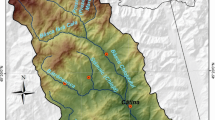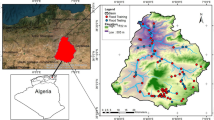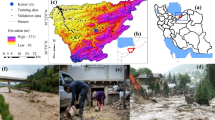Abstract
Flash-floods are among the natural risk phenomena that annually cause important material damages and losses of human lives worldwide. One of the main activities for mitigating the negative effects of these phenomena consist of the identification and spatial representation of the surfaces prone to surface runoff occurrence. Flash-Flood Potential Index (FFPI) is the common method used to assess the degree of susceptibility to flash-floods of a certain surface. The main drawback of the aforementioned method is represented by the fact that, in the majority of the studies, the geographical factors considered for FFPI calculation received equal weights, even if they do not influence in the same measure the surface runoff process. Moreover, within the methodologies developed in the previous studies, the areas affected by torrential phenomena have not been considered for FFPI computation. To address these shortcomings, in the present study, FFPI values are estimated by using a number of 4 stand-alone models (Alternating Decision Tree (ADT), Rotation Forest, Weights of Evidence (WOE), Logistic Model Tree) and 3 hybrid models generated by the integration of WOE model with each of the other decision tree-based algorithms. The first stage of the study consisted of the inventory of the areas where torrential phenomena occurred in the past, 70% of them being included in the training sample, while the others 30% in the validating sample. Further, 12 flash-flood conditioning factors, selected through the correlation-based feature selection algorithm, were used to train the 7 models applied for FFPI calculation. The results of the 7 models revealed that the surfaces with a high and very high flash-flood susceptibility occupy between 23.3 and 43.7% of the entire study zone. The ROC Curve method was involved in the models performance assessment and in the results validation procedure. From this point of view, the best results were obtained by the ADT-WOE hybrid model.


















Similar content being viewed by others
References
Agterberg FP (1992) Combining indicator patterns in weights of evidence modeling for resource evaluation. Nat Res Res 1(1):39–50
Alkhasawneh MS, Ngah UK, Tay LT, Isa M, Ashidi N, Al-batah MS (2013) Determination of important topographic factors for landslide mapping analysis using MLP network. Sci World J 2013:1–12. https://doi.org/10.1155/2013/415023
Althuwaynee OF, Pradhan B, Park HJ, Lee JH (2014) A novel ensemble bivariate statistical evidential belief function with knowledge-based analytical hierarchy process and multivariate statistical logistic regression for landslide susceptibility mapping. Catena 114:21–36
Arnoldus HM (1980) An approximation of the rainfall factor in the universal soil loss equation. In: de Boodts M, Gabriels D (eds) Assessments of erosion. Wiley, Chichester, pp 127–132
Arrighi C, Rossi L, Trasforini E, Rudari R, Ferraris L, Brugioni M, Castelli F (2018) Quantification of Flood risk mitigation benefits: a building-scale damage assessment through the RASOR platform. J Environ Manag 207:92–104
Bathrellos GD, Karymbalis E, Skilodimou HD, Gaki-Papanastassiou K, Baltas EA (2016) Urban flood hazard assessment in the basin of Athens Metropolitan city, Greece. Environ Earth Sci 75(4):319
Bui DT, Ho TC, Revhaug I, Pradhan B, Nguyen DB (2013) Landslide susceptibility mapping along the national road 32 of Vietnam using GIS-based J48 decision tree classifier and its ensembles. In: Cartography from pole to pole: selected contributions to the XXVIth international conference of the ICA. Springer, Dresden, p 303
Bui DT, Tuan TA, Klempe H, Pradhan B, Revhaug I (2016) Spatial prediction models for shallow landslide hazards: a comparative assessment of the efficacy of support vector machines, artificial neural networks, kernel logistic regression, and logistic model tree. Landslides 13(2):361–378
Cao C, Xu P, Wang Y, Chen J, Zheng L, Niu C (2016) Flash flood hazard susceptibility mapping using frequency ratio and statistical index methods in coalmine subsidence areas. Sustainability 8(9):948
Chapi K, Singh VP, Shirzadi A, Shahabi H, Bui DT, Pham BT, Khosravi K (2017) A novel hybrid artificial intelligence approach for flood susceptibility assessment. Environ Model Softw 95:229–245
Chen W, Xie X, Wang J, Pradhan B, Hong H, Bui DT, Ma J (2017a) A comparative study of logistic model tree, random forest, and classification and regression tree models for spatial prediction of landslide susceptibility. Catena 151:147–160
Chen W, Shirzadi A, Shahabi H, Ahmad BB, Zhang S, Hong H, Zhang N (2017b) A novel hybrid artificial intelligence approach based on the rotation forest ensemble and naïve Bayes tree classifiers for a landslide susceptibility assessment in Langao County, China. Geomat Nat Hazards Risk 8(2):1955–1977
Chen W, Pourghasemi HR, Zhao Z (2017c) A GIS-based comparative study of Dempster-Shafer, logistic regression and artificial neural network models for landslide susceptibility mapping. Geocarto Int 32(4):367–385
Chen W, Yan X, Zhao Z, Hong H, Bui DT, Pradhan B (2018) Spatial prediction of landslide susceptibility using data mining-based kernel logistic regression, naive Bayes and RBFNetwork models for the Long County area (China). Bull Eng Geol Environ 78:1–20
Conforti M, Pascale S, Robustelli G, Sdao F (2014) Evaluation of prediction capability of the artificial neural networks for mapping landslide susceptibility in the Turbolo River catchment (northern Calabria, Italy). Catena 113:236–250
Costache R (2014) Using GIS techniques for assessing lag time and concentration time in small river basins. Case study: Pecineaga river basin, Romania. Geogr Techn 9(1):31–38
Costache R, Zaharia L (2017) Flash-flood potential assessment and mapping by integrating the weights-of-evidence and frequency ratio statistical methods in GIS environment–case study: BâscaChiojdului River catchment (Romania). J Earth Syst Sci 126(4):59
Demir G, Aytekin M, Akgun A (2015) Landslide susceptibility mapping by frequency ratio and logistic regression methods: an example from Niksar-Resadiye (Tokat, Turkey). Arab J Geosci 8(3):1801–1812
Diakakis M, Deligiannakis G, Pallikarakis A, Skordoulis M (2016) Factors controlling the spatial distribution of flash flooding in the complex environment of a metropolitan urban area. The case of Athens 2013 flash flood event. Int J Disaster Risk Reduct 18:171–180
Ding Q, Chen W, Hong H (2017) Application of frequency ratio, weights of evidence and evidential belief function models in landslide susceptibility mapping. Geocarto Int 32(6):619–639
Dou J, Yamagishi H, Pourghasemi HR, Yunus AP, Song X, Xu Y, Zhu Z (2015) An integrated artificial neural network model for the landslide susceptibility assessment of Osado Island, Japan. Nat Hazards 78(3):1749–1776
Dou J, Yamagishi H, Zhu Z, Yunus AP, Chen CW (2018) TXT-tool 1.081-6.1 A comparative study of the binary logistic regression (BLR) and artificial neural network (ANN) models for GIS-based spatial predicting landslides at a regional scale. In Sassa K et al (eds) Landslide dynamics: ISDR-ICL landslide interactive teaching tools. Springer, Cham, pp 139–151. https://doi.org/10.1007/978-3-319-57774-6_10
Douvinet J, Van De Wiel MJ, Delahaye D, Cossart E (2015) A flash flood hazard assessment in dry valleys (northern France) by cellular automata modelling. Nat Hazards 75(3):2905–2929
Eristi H, Demir Y (2012) The feature selection based power quality event classification using wavelet transform and logistic model tree. PrzeglądElektrotechniczny 88(7a):43–48
Georgakakos KP (2006) Analytical results for operational flash flood guidance. J Hydrol 317(1–2):81–103
Glas H, Jonckheere M, Mandal A, James-Williamson S, De Maeyer P, Deruyter G (2017) A GIS-based tool for flood damage assessment and delineation of a methodology for future risk assessment: case study for Annotto Bay, Jamaica. Nat Hazards 88(3):1867–1891
Goetz JN, Brenning A, Petschko H, Leopold P (2015) Evaluating machine learning and statistical prediction techniques for landslide susceptibility modeling. Comput Geosci 81:1–11
Hall MA (1999) Correlation-based feature selection for machine learning. Deptartment of Computer Science, Doctoral dissertation, University of Waikato
Hanger S, Linnerooth-Bayer J, Surminski S, Nenciu-Posner C, Lorant A, Ionescu R, Patt A (2018) Insurance, public assistance, and household flood risk reduction: a comparative study of Austria, England, and Romania. Risk Anal 38(4):680–693
Hanley JA, McNeil BJ (1982) The meaning and use of the area under a receiver operating characteristic (ROC) curve. Radiology 143(1):29–36
Hong H, Pradhan B, Xu C, Bui DT (2015) Spatial prediction of landslide hazard at the Yihuang area (China) using two-class kernel logistic regression, alternating decision tree and support vector machines. Catena 133:266–281
Hong H, Liu J, Zhu AX, Shahabi H, Pham BT, Chen W, Bui DT (2017) A novel hybrid integration model using support vector machines and random subspace for weather-triggered landslide susceptibility assessment in the Wuning area (China). Environ Earth Sci 76(19):652
Hong H, Liu J, Bui DT, Pradhan B, Acharya TD, Pham BT, Ahmad BB (2018a) Landslide susceptibility mapping using J48 decision tree with adaboost, bagging and rotation forest ensembles in the Guangchang area (China). Catena 163:399–413
Hong H, Tsangaratos P, Ilia I, Liu J, Zhu AX, Chen W (2018b) Application of fuzzy weight of evidence and data mining techniques in construction of flood susceptibility map of Poyang County, China. Sci Total Environ 625:575–588
Jenness JS (2000) The effects of fire on Mexican spotted Owls in Arizona and New Mexico. MSc thesis. Northern Arizona University, p 137
Kavzoglu T, Sahin EK, Colkesen I (2014) Landslide susceptibility mapping using GIS-based multi-criteria decision analysis, support vector machines, and logistic regression. Landslides 11(3):425–439
Kayastha P, Dhital MR, De Smedt F (2012) Landslide susceptibility mapping using the weight of evidence method in the Tinau watershed, Nepal. Nat hazards 63(2):479–498
Kazakis N, Kougias I, Patsialis T (2015) Assessment of flood hazard areas at a regional scale using an index-based approach and analytical hierarchy process: application in Rhodope-Evros region, Greece. Sci Total Environ 538:555–563
Khosravi K, Nohani E, Maroufinia E, Pourghasemi HR (2016) A GIS-based flood susceptibility assessment and its mapping in Iran: a comparison between frequency ratio and weights-of-evidence bivariate statistical models with multi-criteria decision-making technique. Nat Hazards 83(2):947–987
Khosravi K, Pham BT, Chapi K, Shirzadi A, Shahabi H, Revhaug I, Bui DT (2018) A comparative assessment of decision trees algorithms for flash flood susceptibility modeling at Haraz watershed, northern Iran. Sci Total Environ 627:744–755
Kourgialas NN, Karatzas GP (2011) Flood management and a GIS modelling method to assess flood-hazard areas—a case study. Hydrol Sci J-J des Sci Hydrol 56(2):212–225
Kruzdlo R, Ceru J (2010) Flash Flood Potential Index for WFO Mount Holly/Philadelphia. In: Eastern region flash flood conference, poster session, NOAA’s National Weather Service, pp 2–4)
Landwehr N, Hall M, Frank E (2005) Logistic model trees. Machine learning 59(1–2):161–205
Lee S (2005) Application of logistic regression model and its validation for landslide susceptibility mapping using GIS and remote sensing data. Int J Remote Sens 26(7):1477–1491
Liu KY, Lin J, Zhou X, Wong ST (2005) Boosting alternating decision trees modeling of disease trait information. In: BMC genetics, vol 6(1). BioMed Central, p S132
Lombardo L, Cama M, Conoscenti C, Märker M, Rotigliano E (2015) Binary logistic regression versus stochastic gradient boosted decision trees in assessing landslide susceptibility for multiple-occurring landslide events: application to the 2009 storm event in Messina (Sicily, southern Italy). Nat Hazards 79(3):1621–1648
Musy A, Higy C (2010) Hydrology: a science of nature. CRC Press, Boca Raton
Ozcift A, Gulten A (2011) Classifier ensemble construction with rotation forest to improve medical diagnosis performance of machine learning algorithms. Comput Methods Programs Biomed 104(3):443–451
Ozturk U, Wendi D, Crisologo I, Riemer A, Agarwal A, Vogel K, Korup O (2018) Rare flash floods and debris flows in southern Germany. Sci Total Environ 626:941–952
Pham BT, Bui DT, Prakash I, Dholakia MB (2016a) Rotation forest fuzzy rule-based classifier ensemble for spatial prediction of landslides using GIS. Nat Hazards 83(1):97–127
Pham BT, Bui D, Prakash I, Dholakia M (2016b) Evaluation of predictive ability of support vector machines and naive Bayes trees methods for spatial prediction of landslides in Uttarakhand state (India) using GIS. J Geomat 10:71–79
Pham BT, Bui DT, Dholakia MB, Prakash I, Pham HV, Mehmood K, Le HQ (2017a) A novel ensemble classifier of rotation forest and Naïve Bayer for landslide susceptibility assessment at the Luc Yen district, Yen Bai Province (Viet Nam) using GIS. Geomat Nat Hazards Risk 8(2):649–671
Pham BT, Bui DT, Prakash I (2017b) Landslide susceptibility assessment using bagging ensemble based alternating decision trees, logistic regression and J48 decision trees methods: a comparative study. Geotech Geol Eng 35(6):2597–2611
Pradhan B, Youssef AM (2011) A 100-year maximum flood susceptibility mapping using integrated hydrological and hydrodynamic models: Kelantan River Corridor, Malaysia. J Flood Risk Manag 4(3):189–202
Rahmati O, Pourghasemi HR (2017) Identification of critical flood prone areas in data-scarce and ungauged regions: a comparison of three data mining models. Water Resour Manag 31(5):1473–1487
Regmi AD, Devkota KC, Yoshida K, Pradhan B, Pourghasemi HR, Kumamoto T, Akgun A (2014) Application of frequency ratio, statistical index, and weights-of-evidence models and their comparison in landslide susceptibility mapping in Central Nepal Himalaya. Arab J Geosci 7(2):725–742
Rodriguez JJ, Kuncheva LI, Alonso CJ (2006) Rotation forest: a new classifier ensemble method. IEEE Trans Pattern Anal Mach Intell 28(10):1619–1630
Romanescu G, Mihu-Pintilie A, Stoleriu CC, Carboni D, Paveluc LE, Cimpianu CI (2018) A comparative analysis of exceptional flood events in the context of heavy rains in the summer of 2010: Siret Basin (NE Romania) Case Study. Water 10(2):216
Ryu J, Jung Y, Kong DS, Park BK, Kim YS, Engel BA, Lim KJ (2016) Approach of land cover based asymptotic curve number regression equation to estimate runoff. Irrig Drain 65:94–104
Saharia M, Kirstetter PE, Vergara H, Gourley JJ, Hong Y, Giroud M (2017) Mapping flash flood severity in the United States. J Hydrometeorol 18(2):397–411
Samela C, Albano R, Sole A, Manfreda S (2018) A GIS tool for cost-effective delineation of flood-prone areas. Comput Environ Urban Syst 70:43–52
ShafapourTehrany M, Shabani F, NeamahJebur M, Hong H, Chen W, Xie X (2017) GIS-based spatial prediction of flood prone areas using standalone frequency ratio, logistic regression, weight of evidence and their ensemble techniques. Geomat Nat Hazards Risk 8(2):1538–1561
Shirzadi A, Bui DT, Pham BT, Solaimani K, Chapi K, Kavian A, Revhaug I (2017) Shallow landslide susceptibility assessment using a novel hybrid intelligence approach. Environ Earth Sci 76(2):60
Siahkamari S, Haghizadeh A, Zeinivand H, Tahmasebipour N, Rahmati O (2018) Spatial prediction of flood-susceptible areas using frequency ratio and maximum entropy models. Geocarto Int 33(9):927–941
Smith G (2003) Flash flood potential: determining the hydrologic response of ffmp basins to heavy rain by analyzing their physiographic characteristics. A white paper available from the NWS Colorado Basin River Forecast Center web site at http://www.cbrfc.noaa.gov/papers/ffp_wpap.pdf
Tehrany MS, Lee MJ, Pradhan B, Jebur MN, Lee S (2014) Flood susceptibility mapping using integrated bivariate and multivariate statistical models. Environ Earth Sci 72(10):4001–4015
Tehrany MS, Pradhan B, Jebur MN (2015) Flood susceptibility analysis and its verification using a novel ensemble support vector machine and frequency ratio method. Stoch Environ Res Risk Assess 29(4):1149–1165
Tsangaratos P, Ilia I (2016) Landslide susceptibility mapping using a modified decision tree classifier in the Xanthi Perfection, Greece. Landslides 13(2):305–320
Vaezi AR, Zarrinabadi E, Auerswald K (2017) Interaction of land use, slope gradient and rain sequence on runoff and soil loss from weakly aggregated semi-arid soils. Soil Tillage Res 172:22–31
Van Westen CJ (2002) Use of weights of evidence modeling for landslide susceptibility mapping. International Institute for Geoinformation Science and Earth Observation: Enschede, The Netherlands
Van Westen CJ, Rengers N, Soeters R (2003) Use of geomorphological information in indirect landslide assessment. Nat Hazards 30(3):399–419
Wang LJ, Guo M, Sawada K, Lin J, Zhang J (2016) A comparative study of landslide susceptibility maps using logistic regression, frequency ratio, decision tree, weights of evidence and artificial neural network. Geosci J 20(1):117–136
Wu S, Yu M, Chen L (2017) Nonmonotonic and spatial-temporal dynamic slope effects on soil erosion during rainfall-runoff processes. Water Resour Res 53(2):1369–1389
Yesilnacar E, Topal T (2005) Landslide susceptibility mapping: a comparison of logistic regression and neural networks methods in a medium scale study, Hendek region (Turkey). Eng Geol 79(3–4):251–266
Youssef AM, Al-Kathery M, Pradhan B (2015) Landslide susceptibility mapping at AlHasher area, Jizan (Saudi Arabia) using GIS-based frequency ratio and index of entropy models. Geosci J 19(1):113–134
Youssef AM, Pradhan B, Sefry SA (2016) Flash flood susceptibility assessment in Jeddah city (Kingdom of Saudi Arabia) using bivariate and multivariate statistical models. Environ Earth Sci 75(1):12
Zaharia L, Costache R, Prăvălie R, Minea G (2015) Assessment and mapping of flood potential in the Slănic catchment in Romania. J Earth Syst Sci 124(6):1311–1324
Zaharia L, Costache R, Prăvălie R, Ioana-Toroimac G (2017) Mapping flood and flooding potential indices: a methodological approach to identifying areas susceptible to flood and flooding risk. Case study: the Prahova catchment (Romania). Front Earth Sci 11(2):229–247
Acknowledgements
The author would like to thank the two anonymous reviewers of the Stochastic Environmental Research and Risk Assessment journal, for their critical and valuable comments that helped to improve the article. This study was financially supported by the Research Institute of the University of Bucharest.
Author information
Authors and Affiliations
Corresponding author
Additional information
Publisher's Note
Springer Nature remains neutral with regard to jurisdictional claims in published maps and institutional affiliations.
Rights and permissions
About this article
Cite this article
Costache, R. Flash-flood Potential Index mapping using weights of evidence, decision Trees models and their novel hybrid integration. Stoch Environ Res Risk Assess 33, 1375–1402 (2019). https://doi.org/10.1007/s00477-019-01689-9
Published:
Issue Date:
DOI: https://doi.org/10.1007/s00477-019-01689-9




